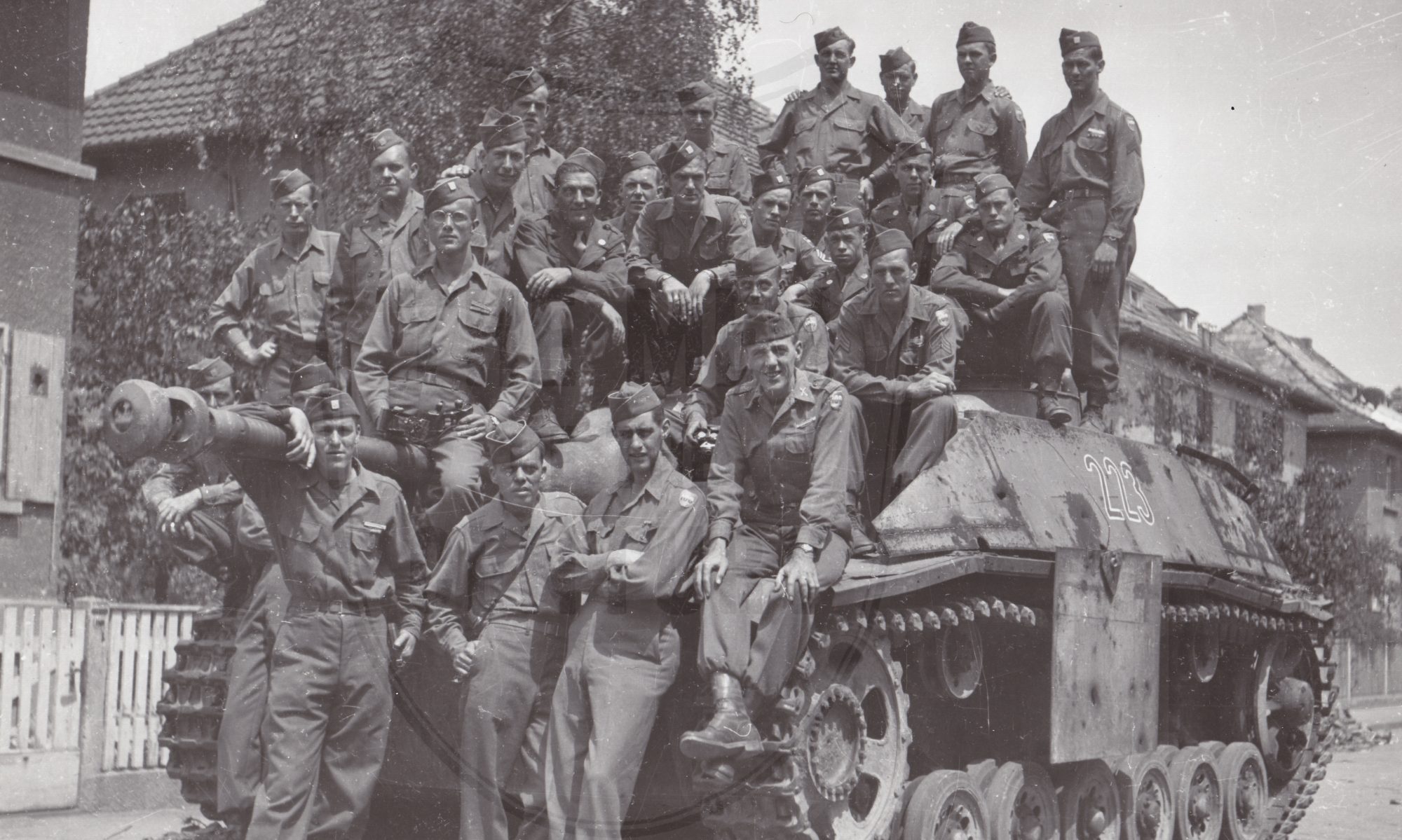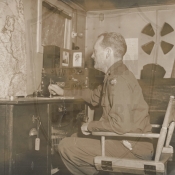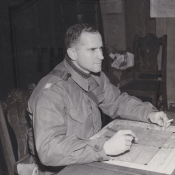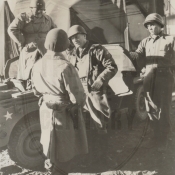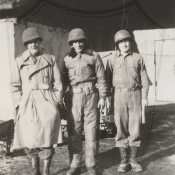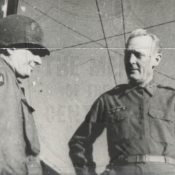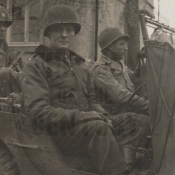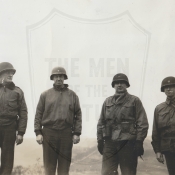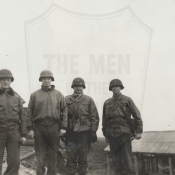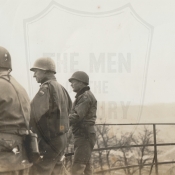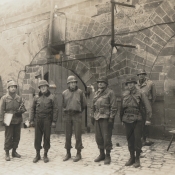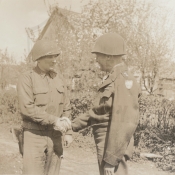
Cold, wet, and completely exhausted after his first night in combat, Corp. Frank Johnson, Brooklyn, artificer, rests somewhere in France on a heap of bed rolls before making the return trip to the nearby fighting, with more blankets and ammunition.

The Century Div. arrived in the combat zone with the medics helmets prominently marked on all sides like the one worn by S/Sgt. Roy G. Carlson, Pencer, Minn. After contact with the enemy in which it was found that the brightly colored headgear gave away the positions of their units, it was changed overnight to the more practical markings on the helmet worn by T/5 James P. Murray Mass. La Salle Area, France. November 3, 1944. Photographed by Sgt. Jacob Harris.

It’s a new experience for these men to be facing the enemy in actual combat. This is the first day in the line. In the foreground prepared position in this main line of resistance is a water cooled 30 Cal. machine gun crew supported by riflemen in the background. Co. M., 399th Infantry Regiment. November 4, 1944.

Major General William W. Eagles, Commander 45th Infantry Division; Major General Withers A. Burress, 100th Infantry Division Commander; Brigadier General John B. Murphy, 100th Infantry Division Artillery; Brigadier General John S. Winn, Attached to 100th Infantry Division. Seventh Army, Rambervillers area, France. November 8, 1944.
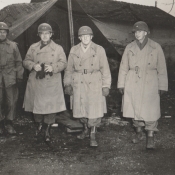
Brigadier General John B. Murphy, 100th Infantry Division Artillery; Major General William W. Eagles, Commander 45th Infantry Division; Major General Withers A. Burress, 100th Infantry Division Commander; Brigadier General John S. Winn, Attached to 100th Infantry Division. Seventh Army, Rambervillers area, France. November 8, 1944.

Seventh Army field artillery unit opens up to beat off German counter-attack in the Rain L’Etape Area in France. Battery ‘B’, 925th Field Artillery Battalion, 100th Infantry Division. Bertrichamps Area, France. November 16, 1944. Photographed by Sgt. Jacob Harris, 163rd Signal Photographic Company.
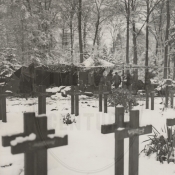
105mm Howitzer set up in snow at the location of French World War I Memorial Cemetery. 375th Field Artillery Battalion, 6th Army Group. St. Remy Area, France. November 17, 1944. T/4 Clifford O. Bell, 163rd Signal Photographic Company.

With the sermon drowned out at times by artillery bursts, church services are carried out in woods which shield the congregation from enemy observation. 2nd Battalion, 399th Infantry Regiment. November 17, 1944.
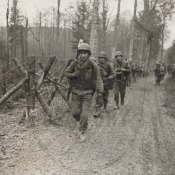
Infantrymen march past barbed wire roadblock as they move up for attack on the town. Headquarters Company, 399th Infantry Regiment, 100th Infantry Division. Raon L’Etape area, France. November 17, 1944. Photographed by T/4 Clifford O. Bell, 163rd Signal Photographic Company.
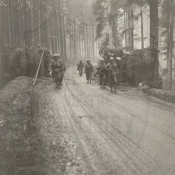
Infantrymen of ‘I’ Company move through rain and mist en route to assault the nearby German-held strong point. The scene is in the forest outside St. Barbe. ‘I’ Company, 398th Infantry Regiment, 100th Infantry Division. Raon L’Etape area, France. November 17, 1944. Photographed by Sgt. Jacob Harris, 163rd Signal Photographic Company.
According to the February 1989 issue of the 100th Division newsletter, these soldiers are from I Co., 398th IR. The soldiers in the left column (from front to back): Capt. Bill Clepper, Lt. Androsko, and Corp. Thomas Roberts. In the right column (from front to back): 1st Sgt. Marvin (Swede) Larsen, Pfc. Maguire, Pfc. McGrade and Pfc. Ernie Ammirato.

Infantrymen of Company ‘K’ plod through rain, mud, and mist en route to assault the nearby town of Raon L’Etape, a German Strong Point. The road runs through the forest of St. Barbe. Company ‘K’, 399th Infantry Regiment, 100th Infantry Division. Raon L’Etape area, France. November 17, 1944. Photographed by Sgt. Jacob Harris, 163rd Signal Photographic Company.

Seventh Army field artillery unit opens up to beat off German counter-attack in France. 925th Field Artillery, 100th Infantry Division, Seventh Army, France. November 17, 1944. Photographed by Sgt. Jacob Harris, 163rd Signal Photographic Company.

Tired Infantryman, Pfc. Norman R. Kimball, Somerville, Mass., takes a break in a German destroyed street in Rain L’Etape, France. 397th Infantry Regiment, 100th Infantry Division, 7th Army. November 18, 1944. Sgt. Jacob Harris, 163rd Signal Photographic Company.

Engineers of the 7th Army repair blasted section of a street in the Rain L’Etape area, France, while in the background white phosphorus shells burst on hill commanded by Nazis. November 18, 1944.

Infantrymen make a dash across a deserted street in the newly liberated town of Rain L’Etape, France. Enemy 88 mm’s still crack intermittently when movement is seen in the street. 397th Infantry Regiment, 100th Infantry Division. November 18, 1944.

Infantrymen (mostly from New York and Pennsylvania) move down the street of the first town of any size taken by this newly arrived outfit. The town was liberated today, Raon L’Etape. Company ‘C’, 397th Infantry Regiment, 100th Infantry Division. Raon L’Etape area, France. November 18, 1944. Photographed by Sgt. Jacob Harris 163rd Signal Photographic Company.

American Infantrymen advance cautiously down a street in the Senones area, France. 1st Battalion, 397th Infantry Regiment, 100th Infantry Division. November 22, 1944.
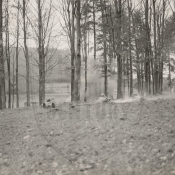
Bazooka projectile explodes after hitting a tree. Target is a German Pill Box holding up American Infantry Advance. Company ‘B’, 397th Infantry Regiment, 100th Infantry Division. St. Blaise Area, France. November 22, 1944. Photographed by T/4 Clifford of the 163rd Signal Photographic Company.

Bazooka man of Company ‘B’ fires into German Pill-Box which has held up the infantry advance for several hours. Company ‘B’, 397th Infantry Regiment, Senones area, France. November 22, 1944. Photographed by T/4 C.O. Bell, 163rd Signal Photographic Company

Bazooka man fires into a German pillbox which has held up the American Infantry advance for several hours. Company ‘B’, 397th Infantry Regiment, 100th Infantry Division. Senones area, France. November 22, 1944.
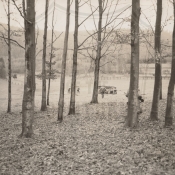
Infantrymen cautiously approach German Pill-Box which has been busted with four bazooka shells. Pill-Box held up advance for several hours. Company ‘B’ 397th Infantry Regiment, 100th Infantry Division. Senones area, France. November 22, 1944. Photographed by T/4 Clifford G. Bell, 163rd Signal Photographic Company.

American Infantrymen of the 1st Battalion, 397th Infantry Regiment, cautiously approach the gates of a cemetery in search of enemy snipers, Senones Area, France. The snipers escaped over the back wall. November 22, 1944. Photographed by Bell.
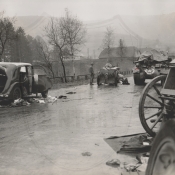
American tank passes by German wagon which had towed 57mm gun. St. Blaise Area, France. November 25, 1944. Photographed by T/4 Bell, 163rd Signal Photographic Company.

Infantrymen of Company, D, 399th Infantry Regiment, pass under the railroad station sign as they advance through Schirmeck. November 25, 1944. Photographed by Bell.
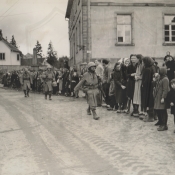
Civilians of Lutzelhouse line edge of the streets to watch American infantrymen advance through the town. Company ‘A’, 399th Infantry Regiment, 100th Infantry Division. Lutzelhouse area, France. November 25, 1944. Photographed by T/4 Clifford O. Bell, 163rd Signal Photographic Company.
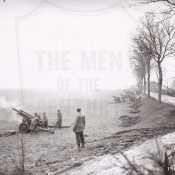
American soldiers of batteries A, B, & C fire from positions side by side along the road. St. Blaise Area, France. 925th Field Artillery Battalion. November 25, 1944.
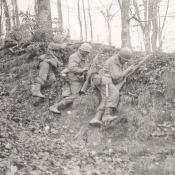
An American infantryman keeps firing while two of his comrades insert fresh ammunition in their rifles, as steady fire from this sheltered infantry covers advance near Rosteig, France. Company ‘K’, 398th Infantry Regiment, 100th Infantry Division. Rosteig Area, France. December 5, 1944. Photographed by Private Francis E. Lane, 163rd Signal Photographic Company.
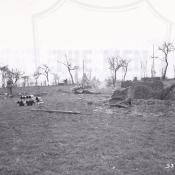
The Cannon Company of the 399th Infantry Regiment, 100th Infantry Division, is set up in an area outside Lemberg. Sarreinsberg, France. December 8, 1944. Photographed by Lane.
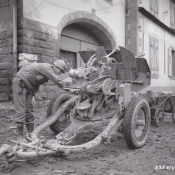
Pfc. Miles Eckerman looks over the structure and mechanism of a German 20-mm flak gun captured intact during fighting for the French town of Lemberg. HQ Co., 1st Battalion, CP 399th Infantry Regiment, 100th Infantry Division. St. Louis area, France. December 9, 1944. Photographed by Lane.
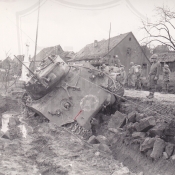
Ditched American M-4 Tank near Lemberg, France, shown just before it was towed back to road by other tanks of the battalion. The other tanks which were linked together, pulled it out using ropes attached to forepart of M-4. Tank slipped into the ditch when road caved in. 781st Tank Battalion, 100th Infantry Division. Lemberg, France. December 12, 1944. Photographed by Pvt. Francis E. Lane, 163rd Signal Photographic Company.
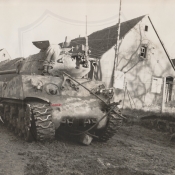
U.S. tankmen start repairs on this M-4 tank which has just been towed from a deep roadside ditch near Lemberg, France. Dislocated tread at left prevented the tank from pulling itself out. Other tanks of the battalion were linked together to tow the damaged tank from ditch. 781st Tank Battalion, 100th Infantry Division. Lemberg France. December 12, 1944. Photographed by Pvt. Francis E. Lane, 163rd Signal Photographic Company.

U.S. Army Engineer removes a German 88mm dud which failed to explode on road outside Lemberg, France. Company ‘B’, 325th Engineer Battalion, 100th Infantry Division. December 12, 1944. Photographed by Pvt. Francis E. Lane, 163rd Signal Photographic Company.
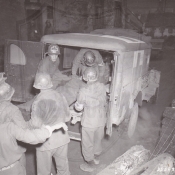
A casualty in the drive west of Bitche, France, is evacuated into an ambulance by medics of Company ‘A’, 325th Medical Battalion, 100th Infantry Division, after receiving first aid at the 1st Battalion Medical Aid Station, 398th Infantry Regiment, 100th Infantry Division, near the front lines in Reyerswiller, France. December 14, 1944. Photographed by Pvt. Francis E. Lane, 163rd Signal Photographic Company.

Infantrymen of Company ‘G’, 2nd Battalion, 398th Infantry Regiment, 100th Infantry Division, stands on guard in front of the telephone trunk terminal, outside his Company’s Forward Command Post, inside the fortifications on the Maginot Line near Bitche, France. December 15, 1944. Photographed by Lane.
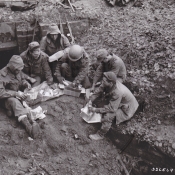
Infantrymen of Company ‘G’, 2nd Battalion, 398th Infantry Regiment, 100th Infantry Division, open Christmas boxes while they are waiting for orders to attack the Maginot Line. Bitche area, France. December 15, 1944. Photographed by Lane.
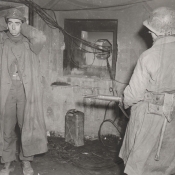
German soldier, guarded by Pvt. Edward Wagner, came out of one of the huge Maginot Line Forts, West of Bitche to surrender as combat engineers close passages from one fort to another by detonation. Company ‘K’, 3rd Battalion, 398th Infantry Regiment, 100th Infantry Division. Bitche, France. December 16, 1944. Photographed by Pfc. Francis E. Lane, 163rd Signal Photographic Company.
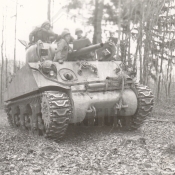
Members of the 100th Infantry Division, stopped momentarily by strong enemy resistance from Maginot Line positions in the Bitche Area, France, stop to study their maps before going into firing position. Left to right: Pvt. Clayton Hored, T/4 Frederick Lowerr, Cpl. Glen Jensen, and Pfc. Joseph Haya. Company ‘A’, 781st Tank Battalion, 100th Infantry Division. Bitche Area, France. December 17, 1944. Photographed by Pfc. Francis E. Lane, 163rd Signal Photographic Company.
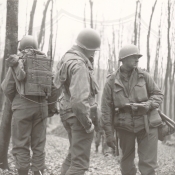
Pfc. Jacob R. Houck; Lt. Col. Harvey Weisel, Commanding Officer 2nd Battalion,;Capt. Matthew Einsmann, Commanding Officer of Company ‘G’, 2nd Battalion; use walkie-talkie radio to converse with Regimental Headquarters while awaiting imminent attack on enemy positions west of Bitch. 2nd Battalion, 398th Infantry Regiment, 100th Infantry Division. Bitche Area, France. December 18, 1944. Photographed by Pfc. Francis E. Lane, 163rd Signal Photographic Company.

Ease before action. American Infantrymen sit relaxed but alert, in a shallow zig-zag trench in a wooded area in France, while waiting for orders to attack enemy forces holding Maginot Line positions. A supporting tank is in the background. Company ‘E’, 2nd Battalion, 399th Infantry Regiment, 100th Infantry Division. Bitche area, France. December 18, 1944.
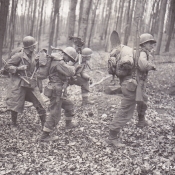
Pvt. Ralph Williams, Pfc. Loid C. Daker, Pfc. Candelario R. Romero, and Sgt. Donald Kauffman, members of Company ‘H’, 2nd Battalion, 398th Infantry Regiment, 100th Infantry Division, wait orders to attack at Maginot Line, West of Bitche, where the enemy is putting up stiff resistance. Bitche, France. December 18, 1944. Photographed by Lane.
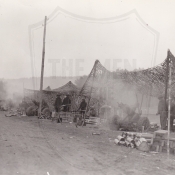
Cannon Company of the 100th Infantry Division fires on enemy forts and troop concentrations near Bitche, France. Cannon Company, 398th Infantry Regiment, 100th Infantry Division, Bitche, France. December 20, 1944. Photographed by Pfc. France E. Lane, 163rd Signal Photographic Company.
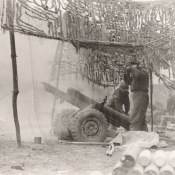
Gun 5 of Cannon Company of the 100th Infantry Division fires on enemy concentrations near Bitche, France. Cannon Company, 398th Infantry Regiment, 100th Infantry Division. Near Bitche, France. December 20, 1944. Photographed by Pfc. Francis E. Lane, 163rd Signal Photographic Company.

Cannon Company man places emplaces shell casings on pile after firing on enemy concentrations near Bitch France. Cannon Company, 398th Infantry Regiment, 100th Infantry Division. December 20, 1944 Photographed by Pfc. Francis E. Lane, 163rd Signal Photographic Company.
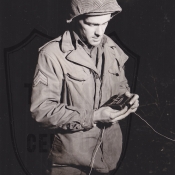
In preparation of an “Abbot T” roadblock Sgt. Howard Brewers, Jersey City, New Jersey, a combat engineer, tests circuit of the explosive with a galvanometer. “Block” is to obstruct possible German counterattack. Company ‘C’, 325th Engineer Battalion, 100th Infantry Division. Mouterhouse Area, France. December 22, 1944. Photographed by T/4 James W. Wood, 163rd Signal Photographic Company.
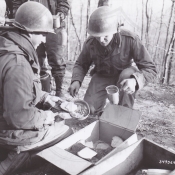
Sgt. Alvin B. Webb, right, is served hot chow by Pvt. Andrew M. Silvoy. The food has just arrived in a wagon from the rear area kitchen. Company ‘B’, 1st Battalion, 399th Infantry Regiment, 100th Infantry Division. Bitche Area, France. December 24, 1944. Photographed by Lane.

Sgt. Raymond S. Howarth, is getting a pack of cigarettes from Sgt. Alvin B. Webb, to place under their Christmas tree above their dug out, while Sgt. Harold W. Has looks on. Company ‘B’, 1st Battalion, 399th Infantry Regiment, 100th Infantry Division at Bitche, France. December 24, 1944. Photographed by Lane.
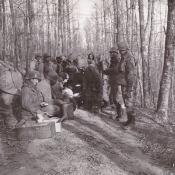
In Bitche area, France, Infantrymen of Company ‘B’, 1st Battalion, 399th Infantry Regiment, 100th Infantry Division, take time out from battle for a hot meal, brought up from their rear area kitchen. December 24, 1944. Photographed by Lane.
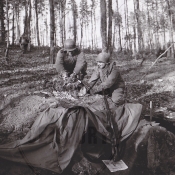
Pvt. Mason S. Gratopp and Pvt. Bernard Goldberg, members of Company ‘B’, 1st Battalion, 399th Infantry Regiment, 100th Infantry Division, Bitche area, France, have their Christmas tree in the open over their earth-covered foxhole. December 24, 1944. Photographed by Lane.
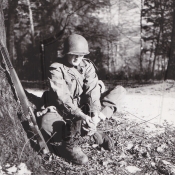
An infantryman of the 399th Infantry Regiment, 100th Infantry Division, changes socks and inter-soles of his snow packs in Wingen, France. Before putting on dry socks he rubs his feet to start circulation. This is done once a day to prevent trenchfoot. January 1st, 1945. Photographed by Lane.
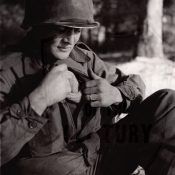
Soldier of 100th Infantry Division reaches inside shirt for a dry pair of socks after massaging his feet. Infantrymen keep socks inside their shirts and next to their bodies where body heat keeps them dry. Wingen France. January 1st, 1945. Photographed by Pfc. Francis E. Lane, 163rd Signal Photographic Company.
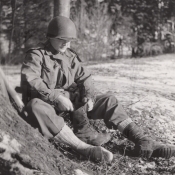
With feet dry and with dry socks on, infantryman of 100th Infantry Division changes inner soles before putting on snow pack. 399th Infantry Regiment, 100th Infantry Division. Wingen, France. January 1st, 1945. Photographed by Pfc. Francis E. Lane, 163rd Signal Photographic Company.
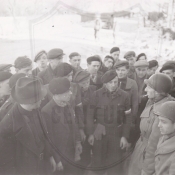
A French liaison officer talks to French deserters of German Army on present state of affairs as he asks them to join up with the Allied Forces to protect their homeland from Nazi counter-thrust. These men range in age from 18 to 27 and fought with the Nazis on the Eastern Front. Lemberg, France. January 2, 1945. Photographed by Pfc. Francis E. Lane, 163rd Signal Photographic Company.
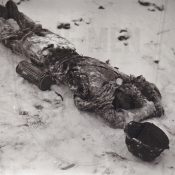
Dead German soldier found near Waldhambach by 100th Infantry Division men. Gas mask canister lies at Nazi’s side. 989th Field Artillery Battalion, 7th Army. January 5, 1945. Photographed by Pfc. Francis E. Lane, 163rd Signal Photographic Company.
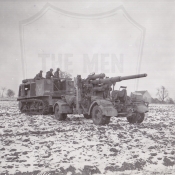
German 86mm gun captured in Strasbourg, is shown being towed by Field Artillery men of the 7th Army, 100th Infantry Division, Battery ‘C’, 989th Field Artillery Battalion, to a position for firing against Nazis in 7th Army sector. Germany. January 5th, 1945. Photographed by Lane.
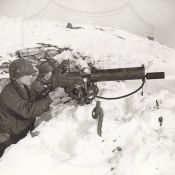
These two machine gunners. Leon D. Outlaw and SSgt. Alphonsa J. Meyers, killed at least one hundred Germans as Americans forces repelled a Nazi counter-attack at Rimlingen. Germans fell so close to their weapon that the Yanks had to move to a new position to continue firing. Company ‘M’, 397th Infantry Regiment, 100th Infantry Division. Achen Area, France. January 12, 1945. Photographed by Pfc. Francis E. Lane, 163rd Signal Photographic Company.

Pvt. Louis C. Hitt and Cpl. Charles E. White, tie barbed wire to a picket these lines, being erected at the front, are put up as a defense, in case our lines are forced to give ground to the enemy. Company ‘B’, 325th Engineer Battalion, 100th Infantry Division. Achen, France. January 15, 1945. Photographed by Pfc. Francis E. Lane, 163rd Signal Photographic Company.
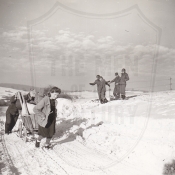
U.S. Engineers stringing barbed wire along the front, stop to watch refugees coming into our lines, on the way to the rear. Company ‘B’, 325th Engineer Battalion, 100th Infantry Division. Achen, France. January 15, 1945. Photographed by Pfc. Francis E. Lane, 163rd Signal Photographic Company.
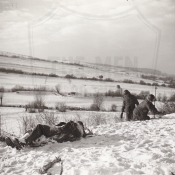
(Left to Right) Engineers Pfc. Hollis E. Miller and T/5 Charles E. White, pass a dead German as they string barbed wire at the front. Company ‘B’, 325th Engineer Battalion, 100th Infantry Division. Achen France. January 15, 1945. Photographed Francis E. Lane, 163rd Signal Photographic Company.
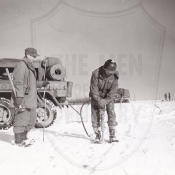
Pvt. Clure Willeford drills into the frozen earth while Pvt. William E. McGinnis prepares to drive picket into hole. These men are constructing barb wire fences on the front line in France. Company ‘B’, 325th Engineer Battalion, 100th Infantry Division. Achen, France. January 15, 1945. Photographed by Pfc. Francis E. Lane, 163rd Signal Photographic Company.
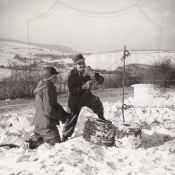
(Left to Right) Cpl. John J. Logan and T/5 Charles E. White, U.S. Army Engineers, brace the end of a barbed wire fence at the front. Company ‘B’, 325th Engineer Battalion, 100th Infantry Division. Achen France. January 15, 1945. Photographed Pfc. Francis E. Lane, 163rd Signal Photographic Company.
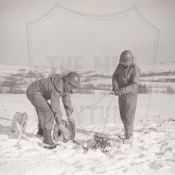
(Left to Right) Pvt. Sheldon D. Kalvar and Pvt. Roy Watson, Army Engineers prepare to construct a barbed wire fence along the front, using captured German wire. Company ‘B’, 325th Engineer Battalion, 100th Infantry Division. Achen, France. January 15, 1945. Photographed by Pfc. Francis E. Lane.
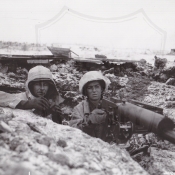
These two U.S. machine gunners, left to right, SSgt. Alphonso J. Meyers and Pfc. Leon D. Outlaw, killed at least one hundred Germans as American forces repelled a Nazi counter attack at Rimling, France. Germans fell so close to their weapon that the Yanks had to move to a new position to continue firing. Company ‘M’, 397th Infantry Regiment, 100th Infantry Division. Achen Area, France. January 17, 1945. Photographed by Lane.
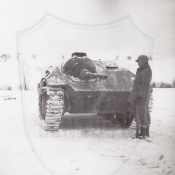
Front view, flame throwing tank. After the Germans took over Czechoslovakia along with the equipment of that country, in the army line, the Germans took the Czech T38 light tank and made it into a flame throwing tank. The 17th SS Panzer Grenadier Division was the first to use this tank on this front, in the anti-personnel role. There were approximately thirty such tanks in this area. This type of tank suffered heavy losses to the southern force of the 100th Infantry Division and Second French Armored Division around Rimling, France. The range of the flame is 55-65 yards and is shot from a dummy gun barrel on the of the tank. (Information from G-2,, 100th Infantry Division). Oermingen, France. January 23, 1945. Photographed by Pfc. Francis E. Lane, 163rd Signal Photographic Company.
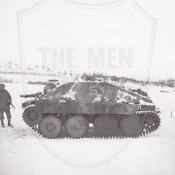
Left side, fame throwing tank. After the Germans took over Czechoslovakia along with the equipment of that country, in the army line, the Germans took the Czech T38 light tank and made it into a flame throwing tank. The 17th SS Panzer Grenadier Division was the first to use this tank on this front, in the anti-personnel role. There were approximately thirty such tanks in this area. This type of tank suffered heavy losses to the southern force of the 100th Infantry Division and Second French Armored Division around Rimling, France. The range of the flame is 55-65 yards and is shot from a dummy gun barrel on the of the tank. (Information from G-2,, 100th Infantry Division). Oermingen, France. January 23, 1945. Photographed by Pfc. Francis E. Lane, 163rd Signal Photographic Company.
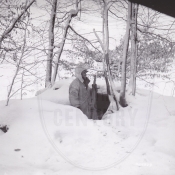
Pfc. David O. Lukins, American Infantryman of the 100th Infantry Division, keeps watch on forward slope of hill a few hundred yards away where Germans are dug in. Shells are falling a short distance away in this snow-covered woods in Reyerswiller. Company ‘I’, 399th Infantry Regiment, 100th Infantry Division. January 24, 1945. Photographed by Pfc. Francis E. Lane, 163rd Signal Photographic Company.
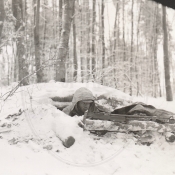
Sgt. Robert N. Kadison, Chicago, Illinois, is on guard with bar in snow-covered foxhole in woods in Reyerswiller, France. Germans hold hill a few hundred yards away. Company I, 399th Infantry Regiment, 100th Infantry Division. January 24, 1945. Photographed by Pfc. Francis E. Lane, 163rd Signal Photographic Company.
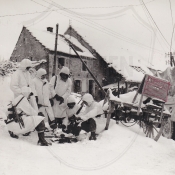
“Trouble Shooters” keep warm over open fire while waiting call to a repair job. They are on call 24 hours a day. 100th Signal Company, 100th Infantry Division. Butten Area, France. January 27, 1945. Photographed by Pfc. Francis E. Lane, 163rd Signal Photographic Company.
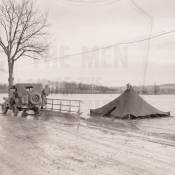
After heavy snowfalls followed by warm weather, rivers and streams overflow their banks, catching unawares the allied armies fighting in France. Here an American soldier looks at a pyramidal tent which is partially submerged under the rising flood. Company ‘A’, 244th Engineer Battalion, 100th Infantry Division. Domfessel, France. February 2, 1945. Photographed by T/5 Francis E. Lane, 163rd Signal Photographic Company.

Truck splashes through flood waters under destroyed railroad trestle. Rising waters has limited traffic to trucks only. 100th Infantry Division Area. Oermingen, France. February 2, 1945. Photographed by T/5 Francis E. Lane, 163rd Signal Photographic Company.
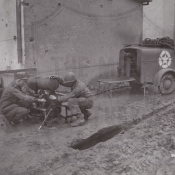
Technician 5th Grade Edward Grant, Evansville, Indiana and Sgt. Martin Carelio, Astoria, Long Island, New York, operating a captured German fire behind the front. This pump draws water from a creek to wash off the white snow-camouflage which combat vehicles had when snow was on the ground. Now GI’s of a service company are giving their vehicles a cleaning from snow and mud they had to travel in to keep them in good running order. Service Company, 397th Infantry Regiment, 100th Infantry Division. Sarre Union, France. February 9, 1945. Photographed by Weintraub.
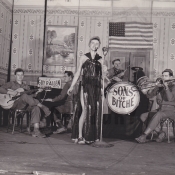
Technician 5th Grade Ed Hines, Mt. Airy, North Carolina, is hot torch singer of all-soldier show, “The Sons of Bitche,” a Service Company’s production playing to frontline troops of 100th Infantry Division, 7th US Army, in Sarre-Union area, France. Corporal Hines designed scenery and costumes and staged dances. Service Company, 398th Infantry Regiment, 100th Infantry Division, 7th US Army, Sarre Union area, France. February 9, 1945. Photographed by T/5 Francis E. Lane, 163rd Signal Photographic Company.
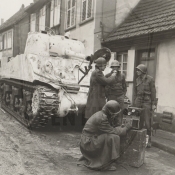
(Left to Right) Staff Sergeant Wallace Irwin of East Setauket, Long Island, New York, Sixth Army Group interviews Sergeant Albert Burnsm 287 Prebla Avenue, Pittsburgh, Pennsylvania and Sergeant Joseph L. Polizzino, 210 Carver Street, Pittsburg, Pennsylvania. Both men are tankers with the 781st Tank Battalion. Interviews are for the Army Hour Program sponsored by the War Department over the NBC. 781st Tank Battalion, 7th Army. Ingwiller, France. February 13, 1945.
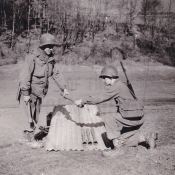
With the bazooka rockets ready to fire, Pfc. Everette W. Ouitt (L) gives a few rounds to Cpl. Ernest L. Cole, who is placing them on the corrugated tin. Ten rockets may be fired at a time, these rounds serve as harassing fire. 1st Battalion, 399th Infantry Regiment, 100th Infantry Division. Lambach Area, France. February 14, 1945. Photographed by T/5 Francis E. Lane, 163rd Signal Photographic Company.
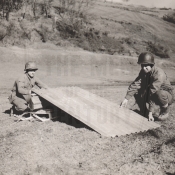
Lt. Col. Ellery M. Zehner, Commanding Officer 1st Battalion, 399th Infantry Regiment, 100th Infantry Division, thought of an idea whereby ten bazooka rockets (M6A3) could be fired at once. He decided to try it out. A piece of corrugated tin was obtained about six ft. long and rounds were to be fired by a battery. The idea proved successful and this “Zehner Whiffle”, as the men call it, was used against the Germans. At one time about 50 rounds were fired, so a bazooka was used to determine the elevation of the corrugated tin. Two infantrymen, Pfc. Thomas A. Dickey (L) and Cpl. John G. Prather, set up the corrugated tin to be used in shooting the bazooka rockets. Pfc. Dickey arranges the corrugated tin, while Cpl. Prather gets ready to sight. 1st Battalion, 399th Infantry Regiment, 100th Infantry Division. Lambach Area, France. February 14, 1945. Photographed by T/5 Francis E. Lane, 163rd Signal Photographic Company.

As bazooka rockets lay on a piece of corrugated tin which will guide them on their way to the desired target. Cpl. Ernest L. Cole wires the ends together so they may be fired by a battery. 1st Battalion, 399th Infantry Regiment, 100th Infantry Division. Lambach Area, France. February 14, 1945. Photographed by T/5 Francis E. Lane, 163rd Signal Photographic Company.
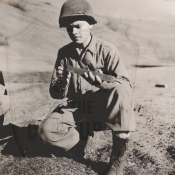
With the bazooka rockets on their improvised launching corrugated tin. Capt. Condee C. Mason, executive officer, connects the electric wires to a B-38 battery from a S-36 radio. This one battery will fire one or ten rockets. 1st Battalion, 399th Infantry Regiment, 100th Infantry Division. Lambach Area, France. February 14, 1945. Photographed by T/5 Francis E. Lane, 163rd Signal Photographic Company.

When the American 7th Army was pushing the Germans towards Bitche, France, the Germans left behind much equipment. Our troops gathered up some of this equipment and are now using it against the enemy. One of the captured German 80mm mortars is shown being fired by three men, (L-R): Sgt. Maxwell E. Gregor, Pfc. Victor A. Sicard, and Sgt. Daniel J. Brandano. One advantage of this mortar is that it may be shot direct fire. Lying in an almost horizontal position, a wire is attached to the fins and run through the bottom of the barrel. When the shell is pulled to the bottom of the barrel, it fires. Company ‘D’, 1st Battalion, 399th Infantry Regiment, 100th Infantry Division. Lambach, France. February 14, 1945. Photographed by T/5 Francis E. Lane, 163rd Signal Photographic Company.

While a group of Company ‘A’ men, of the 399th Infantry Regiment, look on, Maj. Gen. Withers A. Burress, right, Commanding General, 100th Infantry Division, talks with their platoon leader, Lt. Walter L. Bull, left. Lt. Bull was the first enlisted man to receive the Expert Infantry Medal is the US Army from the late Lt. Gen. McNair, and also the first man in the 100th Infantry Division to receive a battlefield commission. Company ‘A’, 1st Battalion, 399th Infantry Regiment, 100th Infantry Division. Sierthal, France. February 15, 1945. Photographed by Francis E. Lane, 163rd Signal Photographic Company.
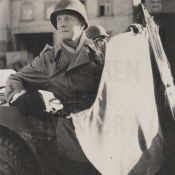
Major General Withers A. Burress, Commanding General 100th Infantry Division. Montbonn, France. February 15, 1945.

Left to Right: Major General Withers A. Burress, Commanding General of 100th Infantry Division, Captain John C. Hammerel (General’s Aide), and T/4 Edward Saeley, Headquarters Company, 100th Infantry Division (General’s Driver). Enroute to 397th Infantry Regiment, 100th Infantry Division, stops to watch shells falling in enemy territory. 397th Infantry Regiment, 100th Infantry Division, 7th Army. Montbronn are, France. February 15, 1945. Photographed by T/5 Francis E. Lane, 163rd Signal Photographic Company.
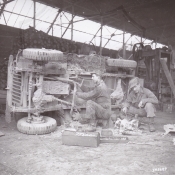
Installing a new clutch in a jeep, are, L to R: Pvt. Wayne McClung, and Tec 5 Francis J. McPhillips, both members of the 800th Ordnance Company, 100th Infantry Division, U.S. Seventh Army. Wolfskirchen, France. February 21, 1945. Photographed by T/5 Francis E. Lane, 163rd Signal Photographic Company.
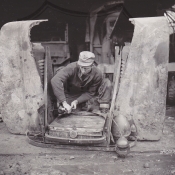
Pfc. Herbert A. Alligood, Mechanic with the 800th Ordnance Company, 100th Infantry Division, Seventh U.S. Army, repairs radiator. Wolfskirchen, France. February 21, 1945. Photographed by T/5 Francis E. Lane, 163rd Signal Photographic Company.
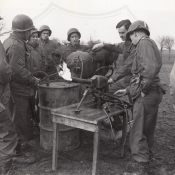
Tankers of the 781st Tank Battalion, gather around the E4-5 Mechanized Flame-thrower. Notice the similarity between the flame-thrower and a .30 cal. machine gun. The flame thrower mounts inside of tank and is inter-changeable with ordinary light machine gun mounted in the front of tanks. The flame thrower has an effective range of 40-60 yards and the fuel tank holds enough fuel for 40 seconds firing time. 781st Tank Battalion, 6th Corps, 7th Army. Bettwiller, France. February 22, 1945. Photographed by T/4 Blau, 163rd Signal Photographic Company.
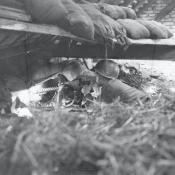
On the alert for any unwary German who may expose himself, Pfc. Jules Bledsoe, Texarkana, Texas, man his .30 cal. machine gun set up in the hay loft of a partially destroyed barn on the Seventh Army Front. Sandbags in front and above position protect him from enemy fire. Company ‘H’, 2nd Battalion, 398th Infantry Regiment, 100th Infantry Division, 7th Army. Sarreinsberg, France. February 28, 1945. Photographed by T/5 Francis E. Lane, 163rd Signal Photographic Company.
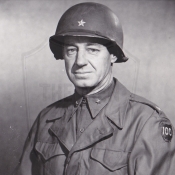
Here is Brigadier General John B. Murphy, Artillery Commander, 100th Infantry Division, ETO, March 1945.

Lt. Col. Ward R. Betz, head of the 100th Infantry Division Chemical Warfare Section and Sgt. William C. French, inspect a new type German flamethrower captured by the 398th Infantry Regiment. It is simple, efficient, and easy to manufacturer. It is operated by single lever on barrel. Ignition is accomplished by the firing of a blank cartridge. Chemical Warfare Section, 100th Infantry Division, 7th Army. Butten Area, France. March 1, 1945. Photographed by T/5 Francis E. Lane, 163rd Signal Photographic Company
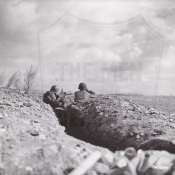
Machine Gunner of the Seventh U.S. Army mans gun in an observation post on the Seventh Army front to guard against surprise attack while American Officer observes enemy mortar fire landing in the battalion positions. 1st Battalion, 399th Infantry Regiment, 100th Infantry Division. Lambach area, France. March 2, 1945. Photographed by Lane.

Left to Right: Unidentified Officer, Brigadier General Whitley; Major General Withers A. Burress, Commanding General 100th Infantry Division; and Major General Wade H. Haislip, Commanding General XVth Corps. Major General Haislip arrives with Brigadier General Whitley, Assistant G-3 at SHAEF, 100th Infantry Division. Brigadier General Whitley shakes hands with General Burress and are introduced by General Haislip before entering the 100th Infantry Division war room, 7th US Army in Butten, France. March 5, 1945. Photographed by T/5 Francis E. Lane, 163rd Signal Photographic Company.
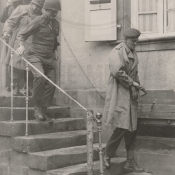
Major General Withers A. Burress, Commanding General 100th Infantry Division, follows Brigadier General Whitley, Assistant G-3 at SHAEF, down steps outside the 100th Infantry Division War Room. Behind General Burress is Major General Wade H. Haislip, Commanding General XVth Corps, who paid a visit to the 100th Infantry Division War Room, 7th US Army in Butten, France. March 5, 1945. Photographed by T/5 Francis E. Lane, 163rd Signal Photographic Company.
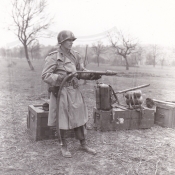
Lt. Col. Ward R. Betz of Lincoln, Nebraska, Chemical Warfare Section Officer, 100th Infantry Division, demonstrates the new US Army model M2-2 Flame Thrower for staff officers of the 100th and 44th Infantry Divisions on the Seventh Army Front. 100th & 44th Infantry Division, XVth Corps, 7th Army. Butten area, France. March 6, 1945. Photographed by T/5 Louis Weintraub, 163rd Signal Photographic Company.
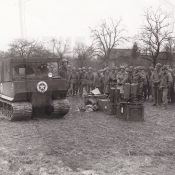
The M-29 Weasel, being issued to all infantry divisions on Seventh Army front, is being demonstrated here to staff of the 100th and 44th Infantry Divisions. 100th & 44th Infantry Divisions, XVth Corps, 7th Army. Butten area. March 6, 1945. Photographed by T/5 Louis Weintraub, 163rd Signal Photographic Company.
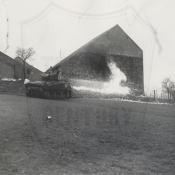
A General Sherman Tank, using the new E-4-5 Flame Thrower, simulates an attack on a pillbox during a demonstration for commanding generals and staffs of the 100th & 44th Infantry Divisions on the Seventh Army front. 100th & 44th Infantry Divisions, XVth Corps, 7th Army. Butten area, France. March 6, 1945. Photographed by T/5 Louis Weintraub, 163rd Signal Photographic Company.

A General Sherman Tank, using the new E-4-5 Flame Thrower, simulates an attack on a pillbox during a demonstration for commanding generals and staffs of the 100th & 44th Infantry Divisions on the Seventh Army front. 100th & 44th Infantry Divisions, XVth Corps, 7th Army. Butten are, France. March 6, 1945. Photographed by T/5 Louis Weintraub, 163rd Signal Photographic Company.
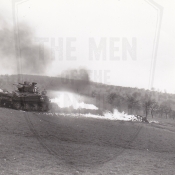
A General Sherman Tank, using the new E-4-5 Flame Thrower, simulates an attack on a pillbox during a demonstration for commanding generals and staffs of the 100th & 44th Infantry Divisions on the Seventh Army front. 100th & 44th Infantry Divisions, XVth Corps, 7th Army. Butten are, France. March 6, 1945. Photographed by T/5 Louis Weintraub, 163rd Signal Photographic Company.
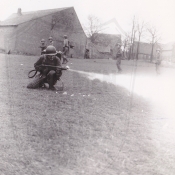
Sgt. George R. Hixon, 4288 Third Avenue, Bronx, New York, fires latest model (M2-2) portable flame thrower during demonstration for staffs and commanding generals of the 100th and 44th Infantry Divisions on Seventh Army front. 100th & 44th Infantry Divisions, XVth Corps, 7th Army. Butten area, France. March 6, 1945. Photographed by T/5 Louis Weintraub, 163rd Signal Photographic Company.
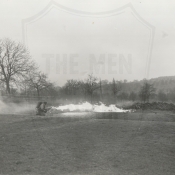
In a simulated assault on a pillbox, the new M2-2 US Army model flamethrower is demonstrated for the staff of the 100th and 44th Infantry Divisions on the Seventh Army Front. 100th & 44th Infantry Divisions, XVth Corps, 7th Army. Butten Area, France. March 6, 1945. Photographed by T/5 Louis Weintraub.
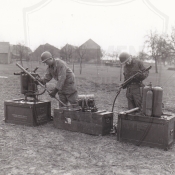
Soldiers compare the new US Army M-2-2 Portable Flame Thrower (Left) with 1942 Model German Flame Thrower during a demonstration of the former for commanding generals of the 100th and 44th Infantry Divisions and their staffs on the Seventh Army front. 100th & 44th Infantry Divisions, XVth Corps, 7th Army. Butten area, France. March 6, 1945. Photographed by T/5 Louis Weintraub, 163rd Signal Photographic Company.
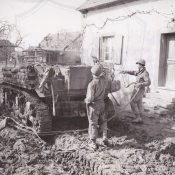
Pvt. George W. Rodgers, Pittsburgh, Pennsylvania, and Cpl. Steve C. Lipinski, 84th Engineer Camouflage Battalion, attached to the 100th Infantry Division, 7th US Army, finish painting a M5-A-1 tank. XVth Corps. Montbronn area, France. March 14, 1945. Photographed by Lane.

Lieutenant General Jacob L. Devers, Commanding General of the 6th Army Group, visits the command post of the 100th Infantry Division. He is shown outside a CP Trailer with Major General Withers A. Burress, Commanding General 100th Infantry Division. 6th Army Group Sector. March 15, 1945. Photographed by Captain Stoen, 6th Army Group.
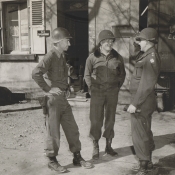
Lieutenant General Jacob L. Devers, Commanding General of the 6th Army Group, visits the command post of the 100th Infantry Division, in the city of Rohrbach. Here he chats with the commanders of the division about their advance as part of the 6th Army Group offensive. Standing in front of the CP Trailer are Brigadier General John J. Murphy, 100th Infantry Division Artillery Commander; Major General Withers A. Burress, Commanding General of the 100th Infantry Division, and General Devers. 6th Army Group Sector. Photographed by March 15, 1945.
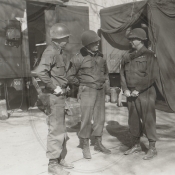
Lieutenant General Jacob L. Devers, Commanding General of the 6th Army Group, visits the command post of the 100th Infantry Division, in the city of Rohrbach. Here he chats with the commanders of the division about their advance as part of the 6th Army Group offensive. Standing in front of the CP Trailer are Brigadier General John J. Murphy, 100th Infantry Division Artillery Commander; Major General Withers A. Burress, Commanding General of the 100th Infantry Division, and General Devers. 6th Army Group Sector. Photographed by March 15, 1945.
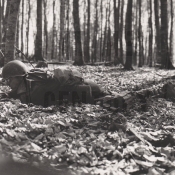
Sgt. Nelson J. Cracken, Baltimore, Maryland, platoon leader of Company ‘A’, 398th Infantry Regiment, 100th Infantry Division, lies flat on the ground while German artillery shells burst a few hundred yards ahead. His platoon was stopped and pinned down while moving up into position to attack. Company ‘A’, 398th Infantry Regiment, 100th Infantry Division, 7th Army. Bitche area, France. March 15, 1945. Photographed by T/5 Francis E. Lane, 163rd Signal Photographic Company
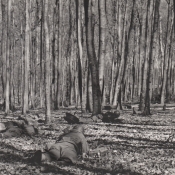
Hitting the Dirt! Spotted by enemy forward observers as they moved forward through the forests near Bitche during new Seventh Army offensive, these 100th Infantry Division infantrymen are forced to hit the ground to escape flying shell fragments from enemy air bursts. Company ‘A’, 398th Infantry Regiment, 100th Infantry Division, XVth Corps, 7th Army. Bitche area, France. March 15, 1945. Photographed by T/5 Francis E. Lane, 163rd Signal Photographic Company.
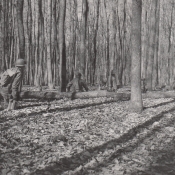
Infantrymen of Company ‘A’, 398th Infantry Regiment, 100th Infantry Division, XVth Corps, US Seventh Army, spotted by forward German observers are subjected to artillery barrage. Tired G.I.’s kneel down while scouts made a reconnaissance of the area ahead. Bitche area, France. March 15, 1945. Photographed by T/5 Francis E. Lane, 163rd Signal Photographic Company.
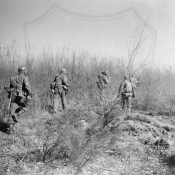
Infantrymen move through brush on way into position to attack their objective, Bitche, France. Company ‘A’, 1st Battalion, 398th Infantry Regiment, 100th Infantry Division, XVth Corps, 7th Army. Bitche Area, France. March 15, 1945. Photographed by T/5 Francis E. Lane, 163rd Signal Photographic Company.
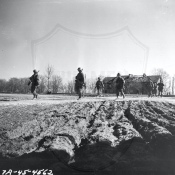
Infantry move up in double column to attack their objective, Bitche, France. Company ‘B’, 1st Battalion, 398th Infantry Regiment, 100th Infantry Division, XVth Corps, 7th Army. Bitche Area, France. March 15, 1945. Photographed by T/5 Francis E. Lane, 163rd Signal Photographic Company.
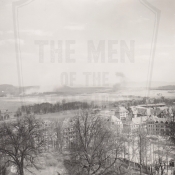
Having fled the fortress city of Bitche, the Germans take cover in the woods north of town. American artillery shells their positions with white phosphorus. 100th Infantry Division, XVth Corps, 7th Army. Bitche, France. March 16, 1945. Photographed by T/5 Francis E. Lane, 163rd Signal Photographic Company.
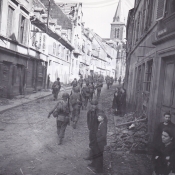
Troops of the 100th Infantry Division, XVth Corps, Seventh Army, move through rubble-filled streets of the citadel city of Bitche, France. This city had previously withstood assault for a number of months, but fell in the new Seventh Army offensive. March 16, 1945. Photographed by Lane.
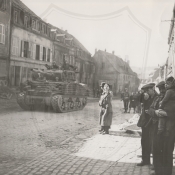
While civilians line the street, Sherman M-4 Tanks pass through Bitche, France, in their pursuit of the fast retreating German troops. The fortress city was not defended this time as it was in December, 1944, when the 100th Infantry Division was at its outskirts. 100th Infantry Division, XVth Corps, 7th Army. Bitche, France. March 16, 1945. Photographed by T/5 Louis Weintraub, 163rd Signal Photographic Company.

M-4 Sherman tanks, 100th Infantry Division, US Seventh Army, enter the city of Bitche, France, after a siege of many months. Civilians greet the Americans as they ride through. 781st Tank Battalion, 100th Infantry Division. March 16, 1945.
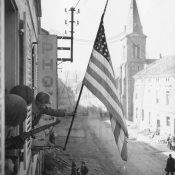
Capt. Thomas H. Garahan, Brooklyn, New York, raises American Fag as Bitche, France, falls to the 100th Infantry Division, US Seventh Army, after a siege of many months. He was with the first troops to enter the town. March 16, 1945.
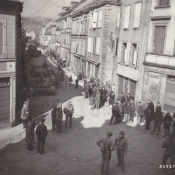
Sherman M-4 tanks line the streets of the fortress city of Bitche. Civilians watch them as they get ready to move, welcoming the American soldiers as they pass through to a new front. 781st Tank Battalion, attached to the 100th Infantry Division, XVth Corps, 7th Army. Bitch France. March 16, 1945. Photographed by Lane.
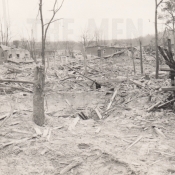
Most of the German garrison barracks at Camp De Bitche, France, were flattened by bombing before the infantry took the town. This is a typical example of the destruction. 100th Infantry Division, XVth Corps, 7th Army. Camp De Bitche, France. March 17, 1945. Photographed by T/4 C. O. Bell.
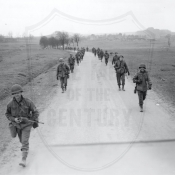
Infantrymen march toward the front in pursuit of the retreating Germans, in the Bitche sector. 399th Infantry Regiment, 100th Infantry Division, XVth Corps, 7th Army. Bitche area, France. March 17, 1945. Photographed by T/4 C. O. Bell, 163rd Signal Photographic Company.
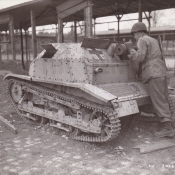
Pfc. Harry J. Tressel, 34 Lindbergh Drive, Buffalo, New York, examines a small German prime mover abandoned by the Nazis in Camp De Bitche, France. 163rd Signal Photographic Company, US Seventh Army. March 17, 1945.
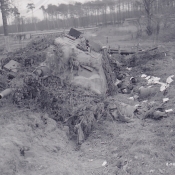
A member of a German light tank crew lies dead next to his skillfully camouflaged tank, near Camp De Bitche, France, captured by troops of US Seventh Army.
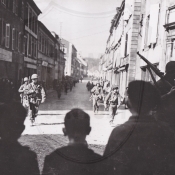
US Troops advance through liberated French Town. Infantrymen of the Seventh US Army march toward the front lines through Bitche shortly after the liberation of the Northern Alsatian city March 17, 1945. The fortress city which withstood German assaults in the Franco-Prussian war and in 1940, was freed of the Nazis two days after the Seventh U.S. Army opened an offensive on a 50-mile front between Saarbrucken and the Rhine River. Less than a week after the attack was launched, Seventh Army armor driving north had linked up with Third Army armored troops pressing southeast. The juncture was made west of Kaiserslautern, Germany.
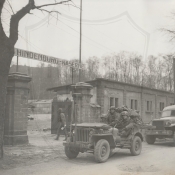
Jeep with 100th Infantry Division combat medics stands in front of the Hindenburg Barracks in Bitche, waiting to move then to the front line. 325th Medical Battalion, 100th Infantry Division, XVth Corps, 7th Army. Bitche, France. March 17, 1945. Photographed by T/5 Louis Weintraub, 163rd Signal Photographic Company.

This is an aerial view of the famous Citadel de Bitche, built on a high hill by the French military engineer Vauban for King Louis XV. The fort, surrounded by the town which grew up around it, was stormed during the Franco-Prussian War, but not captured. Even after the Germans overran France in 1940, the citadel capitulated only after the French and Germans settled with an armistice. Now, for the first time in its history, the old fort fell to men of the 100th Infantry Division, US Seventh Army, on March 16, 1945, at 0700 hours. XVth Corps. March 18, 1945.
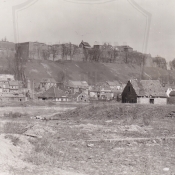
The citadel of Bitche still stands. Built for King Louis XV, it has never been captured until recently, when troops of 100th Infantry Division pushed out German garrison in latest 7th Army drive. Wrecked buildings (fore-ground) testify to the intense fight around Bitche. Bitche, France. March 19, 1945. Photographed by T/5 Pat W. Kohn, 163rd Signal Photographic Company.
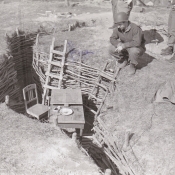
T/4 Andrew Hvizdak, of New York, New York, examines eating utensil left by German soldier in trench at Citadel of Bitche. Bitche France. March 19, 1945. Photographed by T/5 Pat W. Kohn, 163rd Signal Photographic Company.
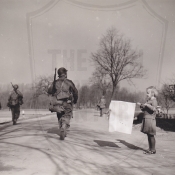
Yank infantrymen pass a young German girl holding a white flag, signifying surrender. These white flags displayed by the civilian populace for protection, have been prevalent during the Seventh Army advance to the Rhine. Company ‘I’, 399th Infantry Regiment, 100th Infantry Division, XXIst Corps, 7th Army. Neuhofen, Germany. March 24, 1945. Photographed by T/5 Francis E. Lane, 163rd Signal Photographic Company.
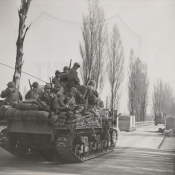
"Tanks loaded with infantrymen pass through the last roadblock between them and the Rhine river. These tired doughboys have been in fast pursuit of the retreating German army for more than three days. Company ‘L', 399th Infantry Regiment, 100th Infantry Division,,XXIst Corps, 7th Army. Ludwigshafen area, Germany. March 24, 1945.
1st Platoon of ‘L’ Company (Lt. MacDonald) was ordered by Lt. Col. B.V. Lenz, commanding officer 3rd Battalion, 399th Infantry Regiment to “get in front of ‘I’ Company, move out and do not stop until you to Altrip on the Rhine.” Lt. MacDonald has hand to helmet, Pfc. Barsam is looking at camera. Pfc. Gemmel is center of turret. Pfc. Sandekiam sits between Barsam and MacDonald."
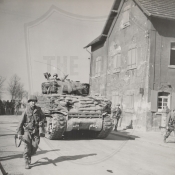
After pursuing the German for three day, tired Infantry stop with the 781st Tank Battalion, 100th Infantry Division, and ride their last distance to the Rhine River. There was no organized resistance from the Germans west to the Rhine River, some snipers were left behind to slow up the fast advancing infantry men. Company ‘I’, 399th Infantry Regiment, 100th Infantry Division, XXIst Corps, 7th Army. Ludwigshafen area, Germany. March 24, 1945. Photographed by T/5 Francis E. Lane, 163rd Signal Photographic Company.

German prisoners march past a sign in Neustadt, Germany, recently entered by [7th] US Army Troops. The sign reads “We will never surrender.” 100th Infantry Division, [7th] US Army, Neustadt, Germany. March 24, 1945. Photographed by Pvt. T.R. Romero, 166th Signal Photographic Company.
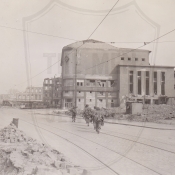
In their mopping up operations in Ludwigshafen, Germany, infantrymen of the 100th Infantry Division move across a street in the center of the city. Although all organized resistance has ceased in the city, snipers are active and the enemy is lobbing in mortar and artillery fire from the east bank of the Rhine, which passes between the city and Mannheim. 100th Infantry Division, XXIst Corps, 7th Army. Ludwigshafen, Germany. March 25, 1945. Photographed by T/4 James W. Todd, 163rd Signal Photographic Company.

Ludwigshafen, Germany. March 28, 1945. Photographed by T/5 Francis E. Lane, 163rd Signal Photographic Company.
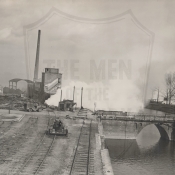
Smoke generator and anti-aircraft gun on river [across] from pontoon bridge protect it from possible enemy air activity. Rhine can be seen in background but not bridge. 7th Army. Ludwigshafen, Germany. March 31, 1945. Photographed by Sgt. Robert G. Heller.

Infantrymen meet a patrol of the French Army on a fork of the road leading into Hochenheim, Germany. The 100th Infantry Division came down the east side of the Rhine to help the French Army in their Rhine River crossing and this is the first meeting of the two armies. Company ‘F’, 2nd Battalion 399th Infantry Regiment, 100th Infantry Division, VIth Corps, 7th Army. Hochenheim Area, Germany. April 1, 1945. Photographed by T/5 Francis E. Lane, 163rd Signal Photographic Company.
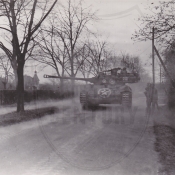
Enemy Destroyer: Muzzle blast from 76mm guns swirl dust around M-18 Tank Destroyer. After firing in support of infantry attacking Wiesloch, Germany. Observer on tank watches result of fire mission. 2nd Battalion, 397th Infantry Regiment, 100th Infantry Division, VIth Corps, 7th Army. Wiesloch, Germany. April 2, 1945. Photographed by Lt. Harold L. Valentine, 163rd Signal Photographic Company.
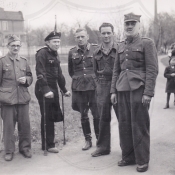
Wounded German soldiers and wounded French and Polish prisoners line the road in front of German hospital watching column of American Soldiers move into Wiesloch today. The retreating Germans lacked sufficient transportation to evacuate the wounded and these men came out to watch the American attack on the village. 2nd Battalion, 397th Infantry Regiment, 100th Infantry Division, VIth Corps, 7th Army. Wiesloch, Germany. April 2, 1945. Photographed by Lt. Harold L. Valentine, 163rd Signal Photographic Company
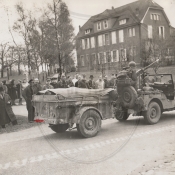
Wounded German soldiers and wounded French and Polish prisoners line road in front of a German hospital watching column of American soldiers move into Wiesloch, Germany, today. Retreating Germans lacked sufficient transportation to evacuate the wounded and the men came out to watch the American attack on the village. 2nd Battalion, 397th Infantry Regiment, 100th Infantry Division, VIth Corps, 7th Army. Wiesloch, Germany. April 2, 1945. Photographed by Lt. Harold L. Valentine, 163rd Signal Photographic Company.
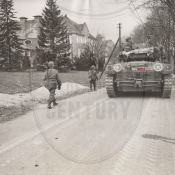
An M-18 Tank Destroyer passing a column of infantry moving up to attack Wiesloch. 2nd Battalion, 397th Infantry Regiment, 100th Infantry Division, VIth Corps, 7th Army. Wiesloch, Germany. April 2, 1945. Photographed by Lt. Harold L. Valentine, 163rd Signal Photographic Company.
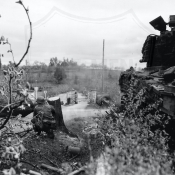
The convincer! Infantryman crouches behind a stump while tank fires pointblank into sniper nest in the house on hill. 76mm shells smashing through their hideout convinced 15 Germans that it was time to surrender. 2nd Battalion, 397th Infantry Regiment, 100th Infantry Division, VIth Corps, 7th Army. Wiesloch, Germany. April 2, 1945. Photographed by Lt. Harold L. Valentine, 163rd Signal Photographic Company.
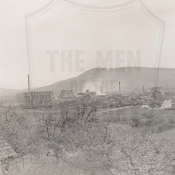
Heilbronn! Smoke rises from American artillery fire in important rail communications town of Heilbronn. Railyards can be seen in foreground. 100th Infantry Division, VIth Corps, 7th Army. Heilbronn, Germany. April 6, 1945. Photographed by T/4 Irving Leibowitz.

The Class 40, 265-Foot span was built in five hours by U.S. Army Engineers against a current of 1 1/2 miles per hour. They worked under cover of a smoke screen laid to obscure them from enemy observation. The site is a short distance upstream from a tread way bridge that was knocked out by German artillery fire from direct observation. The engineers underwent considerable shell-fire while working on the pontoon bridge and finally suspended operation until the Nazis had been routed from their observation post. Company ‘B’, 555th Pontoon Battalion and Company ‘C’ 2826th Engineer Battalion, 7th Army. Heilbronn Germany.
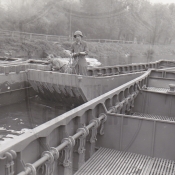
The Class 40, 265-Foot span was built in five hours by U.S. Army Engineers against a current of 1 1/2 miles per hour. They worked under cover of a smoke screen laid to obscure them from enemy observation. The site is a short distance upstream from a tread way bridge that was knocked out by German artillery fire from direct observation. The engineers underwent considerable shell-fire while working on the pontoon bridge and finally suspended operation until the Nazis had been routed from their observation post. Company ‘B’, 555th Pontoon Battalion and Company ‘C’ 2826th Engineer Battalion, 7th Army. Heilbronn Germany.
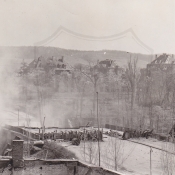
Site of the former bridge across the Neckar River being smoked to conceal from enemy observation the pontoon bridge that is built just to the left of the old bridge that was destroyed by demolitions by the retreating Germans. 1st Battalion, 397th Infantry Regiment, 100th Infantry Division, VIth Corps, 7th Army. Heilbronn, Germany. April 8th, 1945. Photographed by 1st Lt. Harold L. Valentine, 163rd Signal Photographic Company.
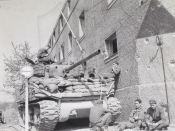
"Tankmen of the 781st Tank Battalion, supporting the 100th Infantry Division, relax while awaiting the construction of a new bridge across the Neckar River in Heilbronn, Germany. The former ponton bridge put in by the engineers was knocked out by effective and accurate artillery fire. 781st Tank Battalion, VI Corps, 7th Army, Heilbronn, Germany. April 9, 1945. Photographed by T/4 Irving Leibowitz of the 163rd Signal Photographic Company.
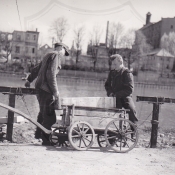
German prisoners load 105mm howitzer shells into assault boats for transport across the Neckar River which flows through the center of Heilbronn, Germany. Nazis are still fighting stubbornly on east side of the river as Seventh Army troops drive them from the town. The city has been resisting for the past five days. 397th Infantry Regiment, 100th Infantry Division, VIth Corps, 7th Army. Heilbronn, Germany. April 9th, 1945. Photographed by T/5 Francis E. Lane, 163rd Signal Photographic Company.
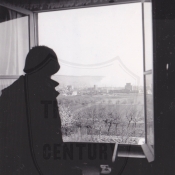
A 7th U.S. Army soldier of the 100th Infantry Division looks out of the OP overlooking the German city of Heilbronn. 100th Infantry Division, VIth Corps, 7th Army. Heilbronn, Germany. April 9th, 1945. Photographed by T/4 Irving Leibowitz, 163rd Signal Photographic Company.
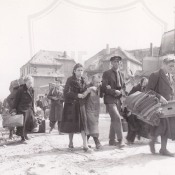
German civilians carry an elderly German woman through the town of Heilbronn, Germany. These were among the many evacuated from the town. 100th Infantry Division, VIth Corps, 7th Army. Heilbronn, Germany. April 9, 1945. Photographed by T/4 Irving Leibowitz

American shells burst on the railroad yards in Heilbronn, Germany. 100th Infantry Division, VIth Corps, 7th Army. Heilbronn, Germany. April 9th, 1945.
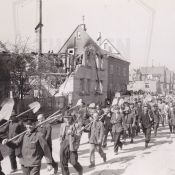
The new German pick and shovel troops! in 1934, when the Nazi party was in its infancy, Hitler organized his famous “Pick and Shovel Troops.” Later to become the famous SS, because the treaty of Versailles prevented the Germans from arming the nation. Hitler got around it by organizing the pick and shovelers, giving them military training but without arms. Here are shown the new German pick and shovelers, German civilians that were evacuated from Heilbronn, Germany, because the civilian population was found to be sniping our troops, with shovels raised on high and marching along Germans roads, but this time to clean the streets for American military Government. 100th Infantry Division, VIth Corps, 7th Army. Heilbronn, Germany. April 9, 1945. Photographed by T/4 Irving Leibowitz, 163rd Signal Photographic Company.
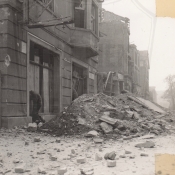
Duck! Two Yank infantrymen cover their heads and hug the walls of destroyed building in bitterly contested Heilbronn, as they hear the warning scream of German Nebelwerfers coming in dangerous close. Third Yank takes cover behind piled up debris. 1st Battalion, 399th Infantry Regiment, 100th Infantry Division, VIth Corps, 7th Army. Heilbronn, Germany. April 11, 1945. Photographed by T/4 Irving Leibowitz, 163rd Signal Photographic Company.
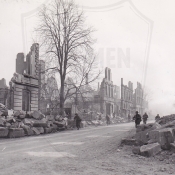
Infantrymen run through streets of Heilbronn, Germany, near former bridge site, while heavy concentration of German nebelwerfer, artillery, and small arms fire continually rake this section of town. 1st Battalion, 399th Infantry Regiment, 100th Infantry Division, VIth Corps, 7th Army. Heilbronn, Germany. April 11, 1945. Photographed by T/4 Irving Leibowitz, 163rd Signal Photographic Company.
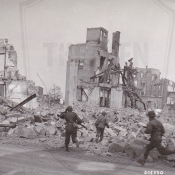
Men of the VIth Corps, 7th US Army, run for cover amidst rubble of destroyed building in Germany, as enemy pours in intermittent artillery, nebelwerfers, and small arms fire. This road and rail communications town, key to southern Germany, has been fanatically contested by resisting German Troops. Heilbronn, Germany. April 11, 1945. Photographed by T/4 Irving Leibowitz, 163rd Signal Photographic Company.
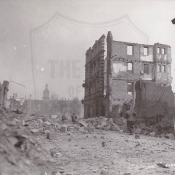
Three Yank Infantrymen dash through rubble—strewn street in Heilbronn, Germany. This town, the gateway to southern Germany, has been fanatically defended by Nazi troops by artillery, nebelwerfer, and small arms fire. 1st Battalion, 399th Infantry Regiment, 100th Infantry Division, 7th Army. Heilbronn, Germany. April 11, 1945.
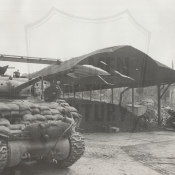
Infantryman cautiously advances past a tank of the 781st Tank Battalion, in factory section of Heilbronn. 781st Tank Battalion, 100th Infantry Division, VIth Corps, 7th Army, Heilbronn, Germany. April 12, 1945. Photographed by T/4 Irving Leibowitz, 163rd Signal Photographic Company.
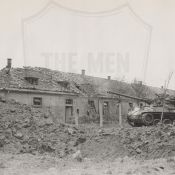
Tank Destroyer of 824th Tank Destroyer Battalion, gives protective cover to 781st Tank Battalion, outside Heilbronn German Barracks. 824th Tank Destroyer & 781st Tank Battalion, VI Corps, 7th Army. Heilbronn, Germany. April 13, 1945. Photographed by T/4 Irving Leibowitz, 163rd Signal Photographic Company
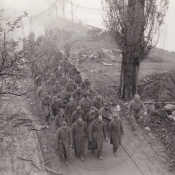
Bitter End. Downcast German prisoners rounded up in the clean up of bitterly resisting Heilbronn, are marched to the rear. Key to southern Germany, Heilbronn was stubbornly defended by these and other Nazis but finally fell before Seventh Army onslaught after nine days of severe fighting. 100th Infantry Division, VIth Corps, 7th Army. Heilbronn, Germany. April 13, 1945. Photographed by T/4 Irving Leibowitz, 163rd Signal Photographic Company.
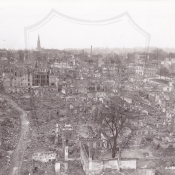
This section of Heilbronn, Germany, has been completely demolished by Allied air attacks, VIth Corps, 7th Army. Heilbronn, Germany. April 13, 1945. Photographed by T/4 Irving Leibowitz, 163rd Signal Photographic Company.
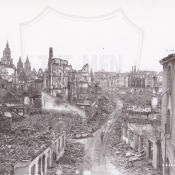
An American soldier walks through the ruins of Heilbronn, Germany, an important road and rail center. 100th Infantry Division, 7th Army. Heilbronn, Germany. April 13, 1945.
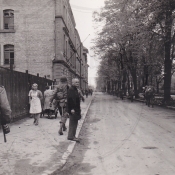
Troops pass through Heilbronn after initial German resistance crumbled. 100th Infantry Division, VIth Corps, 7th Army. Heilbronn, Germany. April 13, 1945. Photographed by T/4 Irving Leibowitz, 163rd Signal Photographic Company.
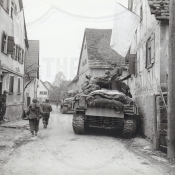
Two tanks, which together with Company ‘H’, captured the village of Scheppbach, pause before moving on. Company ‘H’, 2nd Battalion, 398th Infantry Regiment, 100th Infantry Division, VIth Corps, 7th Army. Scheppbach, Germany. April 15, 1945. Photographed by T/5 Ernest Brown, 163rd Signal Photographic Company.
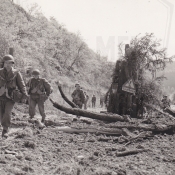
Infantry moves through roadblock towards Lowenstein. Company ‘D’, 1st Battalion, 397th Infantry Regiment, 100th Infantry Division, VIth Corps, 7th Army. Lowenstein, Germany. April 16, 1945. Photographed by T/5 Ernest Brown, 163rd Signal Photographic Company.

A B.A.R man and a rifleman cover some infantrymen whoa re on a sniper hunt. Company ‘A’, 1st Battalion, 397th Infantry Regiment, 100th Infantry Division, VIth Corps, 7th Army. Lowenstein, Germany. April 16, 1945. Photographed by T/5 Ernest Brown, 163rd Signal Photographic Company.
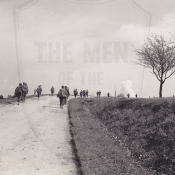
White phosphorus shell lands on German machine gun position as infantry moves towards Ober Fischbach. Company ‘C’, 1st Battalion, 397th Infantry Regiment, 100th Infantry Division, VIth Corps, 7th Army. Ober Fischbach area, Germany. April 18, 1945. Photographed by T/5 Ernest Brown, 163rd Signal Photographic Company.
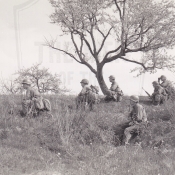
A squad of Company ‘C’, waiting for the signal to jump off. Company ‘C’, 1st Battalion 397th Infantry Regiment, 100th Infantry Division, VIth Corps, 7th Army. Ober Fischbach, Germany. April 18, 1945. Photographed by T/5 Ernest Brown, 163rd Signal Photographic Company.
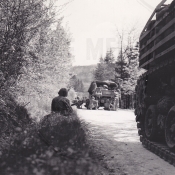
Infantrymen taking cover during heavy enemy shellfire. Company ‘D’, 398th Infantry Regiment, 100th Infantry Division, VIth Coprs, 7th Army. Almhutte area, Germany. April 20, 1945. Photographed by T/5 Ernest Brown, 163rd Signal Photographic Company.
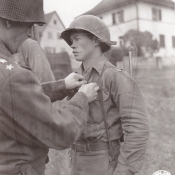
Sgt. Robert W. Barr, who entered military service from Keyser, West Virginia, receives the Silver Star Medal from Maj. Gen. Withers A. Burress, Commanding General of the 100th Infantry Division, for Gallantry in Action. 399th Infantry Regiment, 100th Infantry Division, 7th Army. Germany. April 21, 1945. Photographed by T/5 Ernest Brown, 163rd Signal Photographic Company.
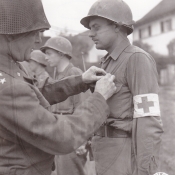
Pfc. Lewis M. Barley, who entered military service from Winchester, Virginia, receives the Silver Star Medal from Maj. Gen. Withers A. Burress, Commanding General of the 100th Infantry Division, for Gallantry in Action. 398th Infantry Regiment, 100th Infantry Division, 7th Army. Germany. April 21, 1945. Photographed by T/5 Ernest Brown, 163rd Signal Photographic Company.
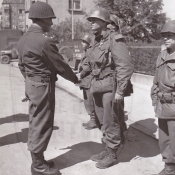
Maj. Gen. Withers A. Burress, Commanding General of the 100th Infantry Division, congratulates Cpl. Marland E. Benner, 397th Infantry Regiment, of 21 Forest Avenue, Springfield, Massachusetts, upon awarding him the Silver Star Medal for Gallantry in Action. 397th Infantry Regiment, 100th Infantry Division, 7th Army. Stuttgart, Germany. April 21, 1945. Photographed by T/4 Gordon T. Freye, 163rd Signal Photographic Company.
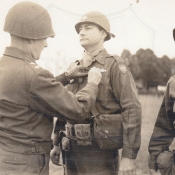
Lt. Col. Ernest L. Janes, Commanding Officer, 3rd Battalion, 398th Infantry Regiment, being presented presidential award ribbon by Maj. Gen. Withers A. Burress, Commanding General, 100th Infantry Division. The 3rd Battalion earned the citation when they breached the formidable positions of the Maginot Line near Bitche. 3rd Battalion, 398th Infantry Regiment, 100th Infantry Division, 7th Army. Stuttgart Area, Germany. April 28, 1945. Photographed by T/4 Albert Gretz, 163rd Signal Photographic Company.
